By Cary Denison Collaboration in water conservation got a shot in the arm last week thanks to the Colorado Foundation for Water Education Gunnison Basin tour. A bus tour can sometimes be an exercise in uncomfortable conversations and car sickness. But the CFWE tour, which started and ended in Gunnison, proved to be a valuable vehicle for removing barriers between water stakeholders and encouraging them to create solutions through compromise and cooperation.
The day and a half long tour introduced participants, who ranged from interested citizenry to the most serious of water wonks, to the natural water wonders and innovative water infrastructure that keeps the fields green, the rivers flowing and the Gunnison Basin breathtaking.
Each tour stop brought a new twist on how agricultural water uses are addressing their unique water supply needs in ways that reduce the impact on other water users and the environment. Trout Unlimited has been partnering on many of these collaborative projects because better management of water means healthier flows for river recreation and trout habitat.
The tour showed that modernizing water systems on the ranch or farm has the potential to make our farms and rivers more sustainable and healthy in the face of drought, rising temperatures and other pressures threatening the larger Colorado River Basin.
Randy Meaker, a farmer near Montrose, welcomed the group and displayed a “big-gun” irrigation system that allows him to more efficiently irrigate his feed crops. Nearby in Olathe, farmer David Harold demonstrated a drip system he is installing on a field that is currently included in the System Conservation Pilot Project, a program that will compensate him and other Colorado River Basin users for conserved water. At a brief stop at Rogers Mesa Fruits, the group heard from local conservancy district president, Tom Alvey, about a new Stream Management Plan sponsored by the district, TU and local conservation groups that will help all water users plan for a more secure water future. Near Hotchkiss we heard from farmer Tom Kay, who explained how using technology like soil moisture sensors and automated sprinklers are helping him grow crops with less water delivered. Tom told us that market-based approaches to water sharing could work as a water conservation tool that protects and compensates farmers. On the road to the small town of Crawford, we heard from Patrice Alonzo, water manager, who discussed how funds provided by the NRCS through partnerships with Trout Unlimited and others will be used to improve irrigation infrastructure, resulting in water savings.
On the second day of the tour we visited Jesse Kruthaupt, TU’s Gunnison Basin Project Specialist, on his family’s ranch on Tomichi Creek, where he explained how they are using a creative lease from the CWCB Instream Flow program to address periods of low flow and compensate for production losses. We wrapped up the tour with a visit to the Trampe Ranch north of Gunnison. Here Bill Trampe and Perry Cabot from the CSU Water Center described how flood irrigation works and how they and partners, including Trout Unlimited, are working toward improving irrigation practices in a manner that works for the producers and conserves water.
And in case you haven’t noticed yet, Trout Unlimited is helping coordinate resources and funding for many of these projects in the Basin.
While it is unlikely that any tour participant went home with a silver-bullet solution for our complex water issues in the Gunnison Basin, it’s safe to say they went home with a better understanding of the water challenges we face—and likely a sense that Trout Unlimited is going to be there to help craft the solutions.
Cary Denison is Gunnison Basin Coordinator for Trout Unlimited.






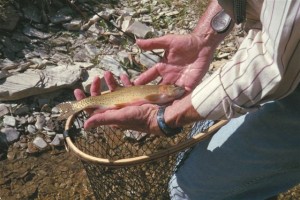
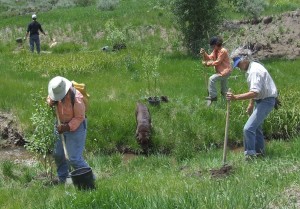
 The water from the Upper Colorado flows from Lake Granby (which acts as the storage facility), then it is is pumped into Shadow Mountain Reservoir where it then flows down into Grand Lake. From Grand Lake, the water then is pumped through the 13.1 mile long Alva B. Adams Tunnel under the Continental Divide and flows into the Big Thompson River. From there, the water drops into power plants that supply the pumps on the western slope.
The water from the Upper Colorado flows from Lake Granby (which acts as the storage facility), then it is is pumped into Shadow Mountain Reservoir where it then flows down into Grand Lake. From Grand Lake, the water then is pumped through the 13.1 mile long Alva B. Adams Tunnel under the Continental Divide and flows into the Big Thompson River. From there, the water drops into power plants that supply the pumps on the western slope.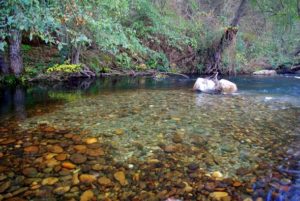 As the flows of the Upper Colorado are depleted by the diversion projects, the natural cleansing of the river fails to occur. Each spring, rivers experience flushing flows- an increase in water flow that breaks up sediment buildup along the stream bed. When the river isn't able to clean itself from sediment buildup between cobblestone, it doesn't allow for insects to hatch or fish to spawn.
As the flows of the Upper Colorado are depleted by the diversion projects, the natural cleansing of the river fails to occur. Each spring, rivers experience flushing flows- an increase in water flow that breaks up sediment buildup along the stream bed. When the river isn't able to clean itself from sediment buildup between cobblestone, it doesn't allow for insects to hatch or fish to spawn. The West needed water to expand. Currently, 80 percent of Colorado's population is on the east of the Divide while 80 percent of the water is on the west side. This means that in order to thrive, water needed to be diverted. The C-BT opened the door to other transmountain diversions- including the Moffat Tunnel from the Fraser River, another tributary of the Upper Colorado headwaters.
The West needed water to expand. Currently, 80 percent of Colorado's population is on the east of the Divide while 80 percent of the water is on the west side. This means that in order to thrive, water needed to be diverted. The C-BT opened the door to other transmountain diversions- including the Moffat Tunnel from the Fraser River, another tributary of the Upper Colorado headwaters.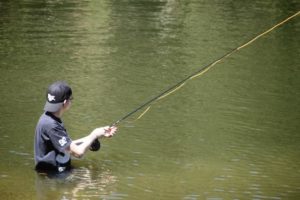 The first day began with a basic entomology class on bugs and their life cycles. Volunteers and camp leaders also showed the students what fish eat, and the flies that represent these species and phases. All of this was don in order to give students a better understanding of what the term “fly” fishing actually means.
The first day began with a basic entomology class on bugs and their life cycles. Volunteers and camp leaders also showed the students what fish eat, and the flies that represent these species and phases. All of this was don in order to give students a better understanding of what the term “fly” fishing actually means.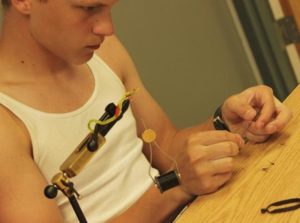
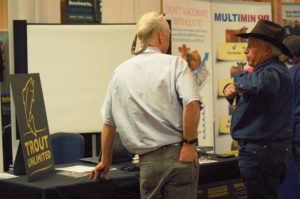
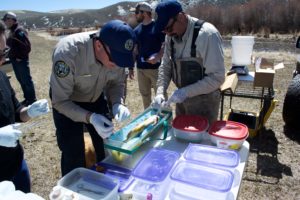 For this project, the chapter and partners purchased 15 RF tags that were surgically implanted into various fish in Tomichi Creek, a tributary of the Gunnison River. By attaching the RF tags to the fish in the creek, the chapter, CPW, and the partners involved could follow these trout and see what kind of movement they did and provide more information as to what causes fish to move.
For this project, the chapter and partners purchased 15 RF tags that were surgically implanted into various fish in Tomichi Creek, a tributary of the Gunnison River. By attaching the RF tags to the fish in the creek, the chapter, CPW, and the partners involved could follow these trout and see what kind of movement they did and provide more information as to what causes fish to move.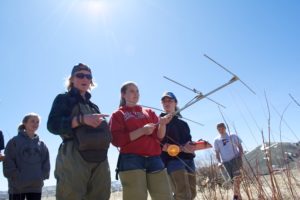 "We have had a few fish travel a pretty good distance. One fish in particular, which was tagged at the Lower Tagging Location, hung out in the same area we had released him in for several weeks. Then right around the same time the runoff started picking up he bolted upstream and was last detected near the confluence of Tomichi and Cochetopa Creeks. A run of over eight miles," said Wiles. "Now there is another tagged fish that has run nearly as far. This leads us to consider that the two missing fish may be farther up the Tomichi. This has effectively expanded our search area from a five mile stretch to who knows how big. Careful what you wish for."
"We have had a few fish travel a pretty good distance. One fish in particular, which was tagged at the Lower Tagging Location, hung out in the same area we had released him in for several weeks. Then right around the same time the runoff started picking up he bolted upstream and was last detected near the confluence of Tomichi and Cochetopa Creeks. A run of over eight miles," said Wiles. "Now there is another tagged fish that has run nearly as far. This leads us to consider that the two missing fish may be farther up the Tomichi. This has effectively expanded our search area from a five mile stretch to who knows how big. Careful what you wish for."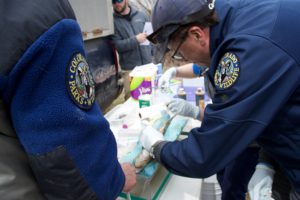 With help from a $2,500 grant from New Belgium Brewing, the chapter is expanding the project to include a website that will have a map of the Tomichi and points to where each fish is located.
With help from a $2,500 grant from New Belgium Brewing, the chapter is expanding the project to include a website that will have a map of the Tomichi and points to where each fish is located.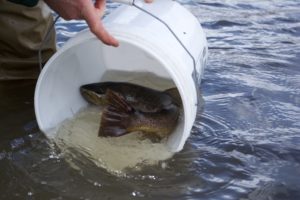 “I wanted to get the program going locally to help students develop more awareness and appreciation for our watershed and I thought the experience might generate some interest in resource management career paths,” said Jesse Kruthaupt, Upper Gunnison Project Specialist for TU. “In addition to those benefits, understanding trout behaviors in this area will be a very useful discussion making and monitoring tool for future restoration work. TU couldn’t have done this alone, Colorado Parks and Wildlife and the Upper Gunnison River Water Conservancy District deserve a big ‘Thank You’ for helping to make this happen.”
“I wanted to get the program going locally to help students develop more awareness and appreciation for our watershed and I thought the experience might generate some interest in resource management career paths,” said Jesse Kruthaupt, Upper Gunnison Project Specialist for TU. “In addition to those benefits, understanding trout behaviors in this area will be a very useful discussion making and monitoring tool for future restoration work. TU couldn’t have done this alone, Colorado Parks and Wildlife and the Upper Gunnison River Water Conservancy District deserve a big ‘Thank You’ for helping to make this happen.” By: Ameen Hosain
By: Ameen Hosain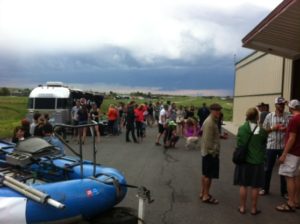
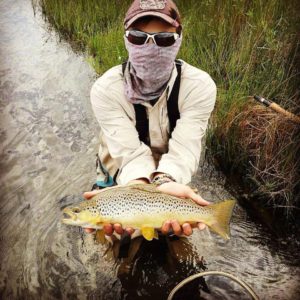
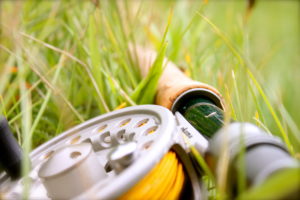

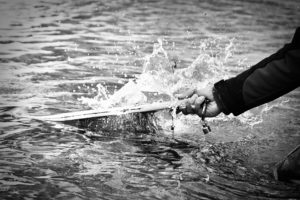 Thus it is best to keep a fish in the water as much as possible, with a photo being taken swiftly- holding the fish only a few inches above the water.
Thus it is best to keep a fish in the water as much as possible, with a photo being taken swiftly- holding the fish only a few inches above the water.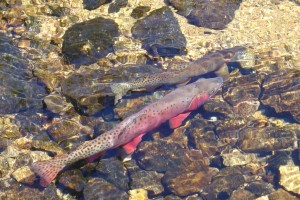 Choosing whether or not to fish to spawning trout is an issue that sees much debate, however with conservation in mind,
Choosing whether or not to fish to spawning trout is an issue that sees much debate, however with conservation in mind,
